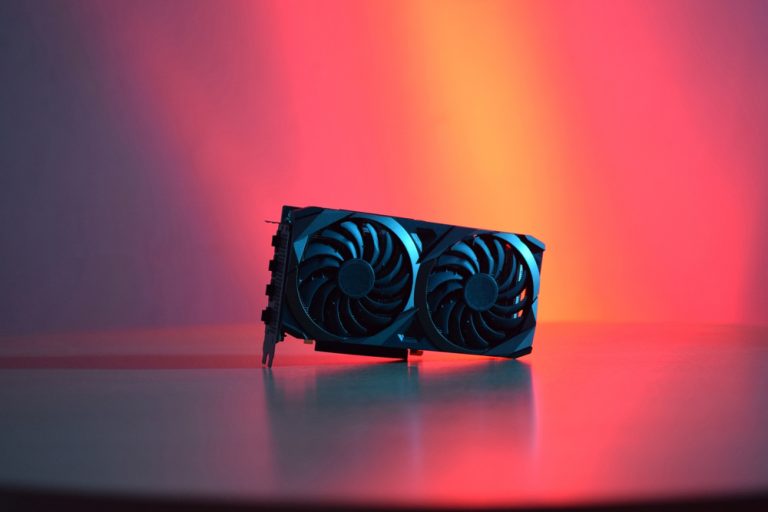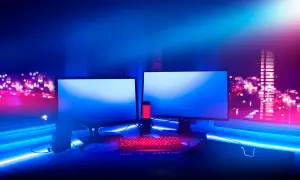Graphics cards, much like CPUs, draw electric energy in order to drive their computational processes. This, however, also generates heat on its circuit board and its chips. The higher the workload, the higher the power draw, and the more heat that accumulates. Thus, normal GPU temperature ranges largely depend on what it is doing at the moment, and how it is (physically) designed to dissipate heat. In this article, we will discuss what normal GPU temperatures are when gaming and idle. We have conducted real real-world tests monitoring both gaming and idle GPU temperatures and have presented the results below.
What is GPU Temperature?
GPU temperature is the mean average calculation of heat energy along the entire circuit board’s surface. It is measured using sensors spread throughout strategic points on the hardware, so generally, it is a mean total of all temperature values, rather than just one single reading. In most modern graphics cards, there is an option to view the hottest reading on any one sensor, which is called the “hotspot”. The standard unit when measuring GPU temperature would be in degrees Celsius (°C).
Why is GPU temperature important?
GPU temperature is important because it establishes the thermal performance limit of the hardware, which is typically referred to as Tj max or the maximum junction temperature of the GPU. At temperatures beyond the Tj max, the GPU starts to significantly throttle itself down in order to prevent high temperatures from causing permanent damage.
That being said, even before Tj max is reached, it is typically recommended to keep GPU temperatures from reaching too uncomfortably close to it. This is to also prevent potential stability issues and to keep the hardware operating perfectly for as long as it possibly could.
What is a normal GPU temp while gaming?
A normal GPU temperature range while gaming should ideally hover around 65° to 85°C (149° to 185°F). Although GPUs are made to run at much higher temperatures, it is ideal to keep temperatures well below 80°C while gaming to prevent heat degradation and a decrease in the lifespan of your GPU.
On average, expect around 70+°C (158+°F) for the whole graphics card, plus around 10 to 15 degrees Celsius more (+18° to 27°F) for hotspot values.
The resolutions at which you play your games can also affect the GPU temps. Lower to medium resolution settings should result in lower GPU temps while gaming. Whereas high game resolution settings will result in higher GPU temps.
Normal GPU temp while gaming test results
Our normal GPU temp while gaming tests resulted in an average GPU temp of 77.2°C, a minimum average GPU temp of 53.3°C, and a maximum average GPU temp of 85.8°C.
| Excellent | Normal | Abnormal | Average gaming GPU temp from our tests | |
|---|---|---|---|---|
| Gaming (98-100% load) | 65 °C or below | 65-85 °C | 85+ °C | 77.2 °C |
What is a normal GPU idle temp?
Normal Idle GPU temperature is roughly 15 – 25°C above room temperature and average room temperature is around 20–22 °C (68–72 °F). Therefore, a good and normal idle GPU temperature range is around 35 to 47°C (95 to 116.6°F).
But, depending on your system and room temperature, you may see higher idle GPU temperatures upwards of 59°C, which is still well within the TJ max of the GPU. However, significantly higher idle GPU temps sustained above 60°C (140°F) are considered abnormal and could mean that there is a problem.
Normal GPU idle temp test results
Our normal idle GPU temp tests resulted in an average idle GPU temp of 38.7°C, a minimum average idle GPU temp of 37.8°C, and a maximum average idle GPU temp of 41.8°C. The GPU’s temps stayed very low and stable at idle.
| Excellent | Normal | Abnormal | Average idle GPU temp from our tests | |
|---|---|---|---|---|
| Idle (10% lower) | 35 °C or below | 35-59 °C | 60+ °C | 38.7 °C |
*Note: The PC we used to test normal gaming and idle GPU temperatures is a SFF (small form factor) Ncase ITX build containing a Ryzen 7 3700X CPU cooled by a Corsair iCUE H100i RGB Pro XT 240mm Water Cooling Kit and an RTX 2060 Super GPU. Therefore, if you have a larger form factor system that is adequately configured you should see lower normal gaming and idle GPU temps. Also, keep in mind there are different technical and environmental factors that could affect results such as your ambient room temperature.
What causes high GPU temperatures?
Drawn power (too) high – temperatures can abnormally increase if the energy used by the GPU exceeds the heat dissipation capability of the cooler. On stock settings, this isn’t usually a problem since the GPU is designed by default to withstand such temperatures. When overclocking with increased power limits, however, this can be a problem, specifically for the lower-tier versions of a certain GPU model (Asus ROG Strix version versus Asus Phoenix version, for example).
Lower-tier cooler and fan design – heat can also somewhat accumulate if the cooler or fans are designed to only provide the bare minimum performance required. For example, the Gigabyte Windforce RTX 2060 dual-fan version has “terrible” thermals, often reaching near 80°C (176°F) compared to other regular models that can stabilize at 68-75 °C (154-167 °F).
Incorrect thermal paste/thermal pad configuration – if the cooling contacts are not applied properly, or are too old. This is especially the case for thermal pads used to cool memory chips since the default ones tend to tear apart very easily when the GPU is disassembled for the first time. Very rarely, a brand-new card could also have incorrectly placed thermal paste or pads due to a factory defect.
Bad case airflow – if the case itself does not provide enough airflow to dissipate the heat blown away by the GPU fans. This could easily raise the default gaming load temperatures by almost 10 degrees Celsius (+9 °F) if not addressed properly.
How to check (and monitor) GPU temperature?
To check and monitor GPU temps, you can use these recommended diagnostic and benchmarking software:
GPU-Z – a handy GPU analysis tool that lists the internal specifications of your GPU, and actively monitors its performance, including real-time GPU temperature. It can even provide specific diagnostics whenever the GPU hits a performance ceiling.
HWInfo64 – a simple application that looks at all the PC components, and gives a detailed information graph of each. Under the GPU section, which is in the lower section of the graphs, the hotspot value will automatically appear right below the total board temperature value if the card can provide it.
Piriform Speccy – PC component utility software with a reduced layout compared to HWInfo64. GPU temps can easily be accessed in the summary section, though info reminiscent of GPU-Z can also be accessed from its dedicated section.
MSI Afterburner – the most popular GPU performance tweaking tool that also provides real-time performance benchmarks. It is also the most recommended overclocking and undervolting tool for graphics cards.
RivaTuner Statistics Server – partner software of MSI Afterburner (installs alongside it). Places benchmark readings of PC components as added visual overlay. Standard GPU temperature is represented by its basic “package” value, which can be toggled on or off.
Nvidia Performance Overlay – same as RivaTuner, adds an overlay that reads GPU (and a bit of CPU) performance including temperature. Does not show up on-screen with recorded gameplay. Exclusive for Nvidia GPUs.
Radeon Overlay – same as Nvidia Performance Overlay, but only exclusive for AMD GPUs.
How to prevent your GPU from overheating?
Use a PC case with good airflow – any well-built, spacious, and sturdy mesh case will do. But, also make sure that the airflow has a uniform direction. It also helps quite considerably if the base area directly below the GPU is open or mesh as well.
Use good quality speed-adjustable case fans – the higher the RPM the better, although it gets considerably noisier the smaller and less optimized the fans are. PWM fans are somewhat better in this regard, as they ramp up in speed depending on the PC’s overall load.
Clean dust from Your PC regularly – use a compressed-air can to clean away accumulated dust from the PC every two weeks or every month. Electric blowers are usually better used (more efficiently used) on PCs that have already accumulated significant amounts of dust (haven’t been cleaned for a long time).
Make the ambient temperature as cool as possible – air conditioning will automatically shave away several degrees of temperature from your GPU. But, a nice and cool (possibly rainy) day could work just as well.
How to lower GPU temperature?
Lower in-game FPS or resolution – reducing the quality of the processed frames, or the number of the frames themselves can lower the overall load of the system, thus significantly lowering heat generation. The change does not have to be drastic. Going from uncapped down to 120 FPS, for example, could already help reduce the temperature by a few degrees. Lowering settings could also help, but the effects are not really as noticeable as when tweaking frames or resolution.
Apply more aggressive fan curves – use a tweaking software like MSI Afterburner to adjust the way the GPU fans ramp up when used. There are two main ways to use this method.
- First is manually editing the curve itself by opening the settings menu and selecting the Fan tab. From there, adjust the points to what temperature and fan percentage level you wish to use.
- The second is by simply setting a static fan percentage setting. Click on the Auto button at the end of the Fan Speed (%) bar. Adjust the slider to the percentage that you want, then click the check button. You can save the profile if needed.
Undervolt the GPU – this is perhaps the most efficient way to reduce the temperature of your GPU while maximizing the watt-to-performance efficiency of your system. This time, use MSI Afterburner to bring up the voltage curve editor using CTRL + F.
- Look first where the curve stops on the graph, or the highest point before it flatlines horizontally.
- Starting from the point where it stops, lower the millivolt (mV) value by increments of 10. The rest of the points till the end (right side) should also have the same mV value. Apply the changes by clicking the Check button beside the Reset button
- Load the game of your choice again to test the load temperatures.
- Once you found a level you are comfortable with, save the profile (click the save button, then click on one of the profile slots 1-5 of your choice). You’ll need to reapply the undervolt every time the PC restarts or reboots.
- Significant changes are usually noticeable at around the -100 mV mark. This is where power draw, and therefore heat, is significantly reduced with barely any effect on in-game FPS. Every GPU result may vary, though, so feel free to experiment with slightly lesser or higher values as needed.
Final Thoughts
Learning how to gauge and control GPU temperature is among the most important things PC enthusiasts should learn when tweaking their personal machines. This is not only because GPUs are considered technological investments today more than ever. But because the temperature is always related to a computer’s potential performance. Even at the higher end of nominally accepted ranges, users should always try to get the best temperature values they can for stabilized operation and extended longevity.
GPU Temperature FAQs
What is a good GPU temp?
Good GPU temperatures on a full workload are around 65 to 75°C (149° to 167°F). This is the point where thermal throttling is a non-issue, damage due to overheating will never occur, and thermal degradation over time basically becomes non-existent.
Is 80 degrees Celsius hot for a GPU?
Yes, it is quite hot. However, (exactly) 80 degrees Celsius (176°F) is still within the spec of most GPUs today. So long as it doesn’t go significantly over 80, it should not be a big issue. For hotspot values, though, 80 degrees Celsius is perfectly normal.
Why is my GPU so hot?
If operating normally, the most likely reasons your GPU is still hot (higher than the accepted spec) would be sub-optimal PC case airflow and lower-tier base cooler/fan design. The first issue can be solved with better airflow configurations, and the second issue can be solved by undervolting.



